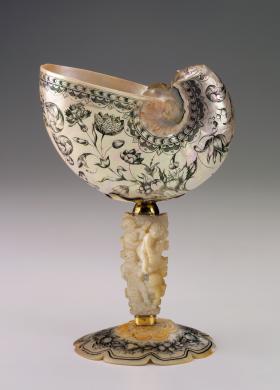
Drinking vessels made of a nautilus shell combined a natural marvel and fine craftsmanship in a useful object. It may be difficult to imagine drinking from such an elaborate cup, but they were used only for special occasions. They were treasures to be admired in collections of curiosities. Dutch artists made a number of nautilus cups during the 17th century, when shells of the chambered nautilus were imported from Indonesia. The Dutch East India Company established one of the first large multinational corporations there, resulting in millions of tons of goods shipped on thousands of vessels. This trade enriched the Netherlands and is reflected in the exotic seashells and other imported objects seen in many Dutch still-life paintings of that century.
Nautilus shells reveal a pearly color and texture when the outer surface is polished away. The craftsman who made this cup was also a painter. He used the smooth white surface as a background for decoration of incised drawings of recognizable flowers, which are highlighted with ink. This was a period of enormous Dutch interest in flowers and plants for the garden, in scientific study, and as subjects in art. The stem and foot of the cup are carved of marine oyster shell. Playful cupids frolic among fruits and grape vines, which might be a reminder of the cup’s purpose. When drinking from the large part of the lip, the drinker would have been confronted by a grotesque face incised into the top of the smaller end, just visible on the right side of the photograph.

